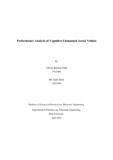| dc.contributor.advisor | Sabuj, Saifur Rahman | |
| dc.contributor.author | Rahul, Ashiqur Rahman | |
| dc.contributor.author | Akbar, Md. Sajid | |
| dc.date.accessioned | 2019-05-16T05:04:37Z | |
| dc.date.available | 2019-05-16T05:04:37Z | |
| dc.date.copyright | 2019 | |
| dc.date.issued | 2019-04 | |
| dc.identifier.other | ID 15121001 | |
| dc.identifier.other | ID 18221056 | |
| dc.identifier.uri | http://hdl.handle.net/10361/12066 | |
| dc.description | This thesis is submitted in partial fulfilment of the requirements for the degree of Bachelor of Science in Electrical and Electronic Engineering, 2019. | en_US |
| dc.description | Cataloged from PDF version of thesis. | |
| dc.description | Includes bibliographical references( pages 33-36). | |
| dc.description.abstract | The traditional spectrum sensing by cognitive radio sometimes decreases as to the effects of fading and shadowing. Besides, Cognitive radio (CR) based unmanned aerial vehicle (UAV) will provide a higher data transmission without severely being affected by the multipath fading and shadowing. In this paper our goal is to maximize the energy efficiency and throughput by minimizing the power consumption of the UAV. We have designed an analytical model where we worked on the air to ground and ground to ground channel gain. For this paper we also have just considered the downlink communication between the UAV and the ground objects. For improving the energy efficiency of the UAV transmission power is reduced and it is done by two mathematical approaches. Firstly, with the Lambert W function we find the optimal transmission power that is later used to increase the energy efficiency. Secondly, two multi-objective optimization problem (MOP) is introduced and with Lagrangian approach we solve the MOPs to find the maximum power transmitted which is to be used for increasing energy efficiency. | en_US |
| dc.description.statementofresponsibility | Ashiqur Rahman Rahul | |
| dc.description.statementofresponsibility | Md. Sajid Akbar | |
| dc.format.extent | 42 pages | |
| dc.language.iso | en | en_US |
| dc.publisher | Brac University | en_US |
| dc.rights | Brac University theses are protected by copyright. They may be viewed from this source for any purpose, but reproduction or distribution in any format is prohibited without written permission. | |
| dc.subject | Unmanned aerial vehicle | en_US |
| dc.subject | Cognitive radio network | en_US |
| dc.subject | Energy efficiency | en_US |
| dc.subject | Spectrum sensing | en_US |
| dc.subject | Power allocation | en_US |
| dc.subject | Multi-objective optimization | en_US |
| dc.subject.lcsh | Natural computation | |
| dc.subject.lcsh | Engineering | |
| dc.subject.lcsh | Drone aircraft--Control systems | |
| dc.title | Performance analysis of cognitive unmanned aerial vehicle | en_US |
| dc.type | Thesis | en_US |
| dc.contributor.department | Department of Electrical and Electronic Engineering, Brac University | |
| dc.description.degree | B. Electrical and Electronic Engineering | |

